A MEMORY
One of my earliest memories is from 1991 in Harrisburg, Pennsylvania. I am little girl sitting on a wooden dance floor in a hotel ballroom. My father wears a colorful costume with his bare chest exposed while swinging a golden wooden sword, as my aunties dressed in shiny lame head to toe, twisting and turning fans with their wrists moving at rapid speed behind him. The sounds of the kulingtang gongs blare on our boombox, long strong bamboos strike the ground in rhythm, and I smell the lumpia my tita prepared as our post rehearsal snack. I think to myself, “One day, that will be me.”
Culture dance is a big part of my identity as an artist. Although I do not partake in it now as a theater director, I spend about 13 years performing cultural dances with the Philippine American Association of Central Pennsylvania. These experiences were essential in making me the Philippine American artist I am today. Performing cultural dances in our Philippine community celebrated our culture in America.
THE FORM
Every country has their own relationship with their cultural performance traditions, and I want to understand it in Thailand. Is it has precious and beloved as my own culture's? I soon learned that it is present in tourism, but nonexistent in everyday culture. Thai Classical Dance exists in two forms: royal and folk. It is mostly known for its royal dances created to entertain the royal court with its elaborate lush costumes, stylized costumes, and pageantry. Different moves and images represent different emotions and feelings. It becomes a language of storytelling, rather than creativity or emotional feeling. The emotion is the precision of each movement. I embarked on my journey to attempt this precision and understand the roots of Thai all Thai performance. In order for me to truly understand form, I must experience it in my own body.
One of my earliest memories is from 1991 in Harrisburg, Pennsylvania. I am little girl sitting on a wooden dance floor in a hotel ballroom. My father wears a colorful costume with his bare chest exposed while swinging a golden wooden sword, as my aunties dressed in shiny lame head to toe, twisting and turning fans with their wrists moving at rapid speed behind him. The sounds of the kulingtang gongs blare on our boombox, long strong bamboos strike the ground in rhythm, and I smell the lumpia my tita prepared as our post rehearsal snack. I think to myself, “One day, that will be me.”
Culture dance is a big part of my identity as an artist. Although I do not partake in it now as a theater director, I spend about 13 years performing cultural dances with the Philippine American Association of Central Pennsylvania. These experiences were essential in making me the Philippine American artist I am today. Performing cultural dances in our Philippine community celebrated our culture in America.
THE FORM
Every country has their own relationship with their cultural performance traditions, and I want to understand it in Thailand. Is it has precious and beloved as my own culture's? I soon learned that it is present in tourism, but nonexistent in everyday culture. Thai Classical Dance exists in two forms: royal and folk. It is mostly known for its royal dances created to entertain the royal court with its elaborate lush costumes, stylized costumes, and pageantry. Different moves and images represent different emotions and feelings. It becomes a language of storytelling, rather than creativity or emotional feeling. The emotion is the precision of each movement. I embarked on my journey to attempt this precision and understand the roots of Thai all Thai performance. In order for me to truly understand form, I must experience it in my own body.
LESSONS
I began lessons with Kru Nid at RumPuree in Bangkok. Kru literally means “teacher,” so I’ve seen this name for many professors and instructors I’ve met in the art world. She is a woman in her 70’s who appears to be a sweet and soft spoken, but after spending one session with her, she quickly revealed her strict and rigorous side. Each session consists of the first 15 minutes of stretching fingers and limbs to painful hyperextension. Each lesson, she tests me to see if I have been practicing at home. She often uses the word “Beautiful!” to complement me. This word is the basis of all Thai Classical Dance.
The lesson continues into learning a routine that focuses on repetitive isolated hand and arm movements while walking in a simple circular formation. It honestly took me three lessons to learn this first warm-up dance. I have pretty good hand and foot coordination, but this was very difficult and painful. She stretched my body in unnatural ways, and the angles created by my fingers and limbs had to be very exact. It’s similar to the game of patting your head and rubbing your tummy at the same time. Overall I like studying Thai Classical Dance. It feels like Tai Chi or Yoga. In the moment, it feels relaxing and calming. At the end, I am exhausted and sore.
I began lessons with Kru Nid at RumPuree in Bangkok. Kru literally means “teacher,” so I’ve seen this name for many professors and instructors I’ve met in the art world. She is a woman in her 70’s who appears to be a sweet and soft spoken, but after spending one session with her, she quickly revealed her strict and rigorous side. Each session consists of the first 15 minutes of stretching fingers and limbs to painful hyperextension. Each lesson, she tests me to see if I have been practicing at home. She often uses the word “Beautiful!” to complement me. This word is the basis of all Thai Classical Dance.
The lesson continues into learning a routine that focuses on repetitive isolated hand and arm movements while walking in a simple circular formation. It honestly took me three lessons to learn this first warm-up dance. I have pretty good hand and foot coordination, but this was very difficult and painful. She stretched my body in unnatural ways, and the angles created by my fingers and limbs had to be very exact. It’s similar to the game of patting your head and rubbing your tummy at the same time. Overall I like studying Thai Classical Dance. It feels like Tai Chi or Yoga. In the moment, it feels relaxing and calming. At the end, I am exhausted and sore.
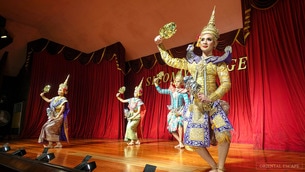 Thai Classical Dancers from Silom Village
Thai Classical Dancers from Silom Village THE REALITY
Many of my Thai friends were required to study Thai classical dance as children. It was a way of preserving the Thai culture. Most people leave and and forget about it, but some continue to pursue it professionally. My feeling is that a lot of Thais reject this traditional form, because they have no relationship to, nor do they really understand why they are doing it. Maybe the why has become, "for entertainment" or "for the tourists." The form may be beautiful for photos, but it lacks emotional depth or any conversation around the characters, stories, emotions. I find myself google the moves and music, hoping a scholar has written something that will help me understand what I am doing. As you can see from the photo above, I am one of two students studying with Kru Nid, and I can see her enthusiasm when I show her my excitement in getting a dance correctly. She often asks me, "Do you like this?" I assure yes, of course, but I notice that the bellydancing class next door has 20 times more students than ours. Frankly, it is a dying form and there are few opportunities to learn from the dedicated traditionalists like Kru Nid.
Many of my Thai friends were required to study Thai classical dance as children. It was a way of preserving the Thai culture. Most people leave and and forget about it, but some continue to pursue it professionally. My feeling is that a lot of Thais reject this traditional form, because they have no relationship to, nor do they really understand why they are doing it. Maybe the why has become, "for entertainment" or "for the tourists." The form may be beautiful for photos, but it lacks emotional depth or any conversation around the characters, stories, emotions. I find myself google the moves and music, hoping a scholar has written something that will help me understand what I am doing. As you can see from the photo above, I am one of two students studying with Kru Nid, and I can see her enthusiasm when I show her my excitement in getting a dance correctly. She often asks me, "Do you like this?" I assure yes, of course, but I notice that the bellydancing class next door has 20 times more students than ours. Frankly, it is a dying form and there are few opportunities to learn from the dedicated traditionalists like Kru Nid.
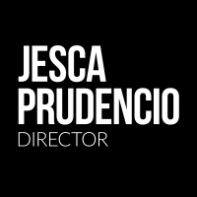
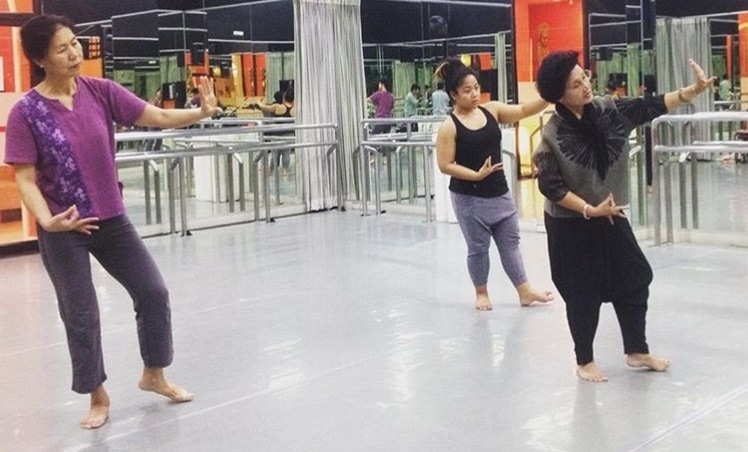
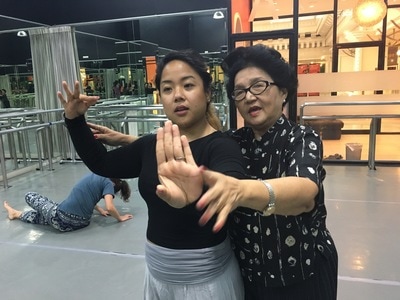
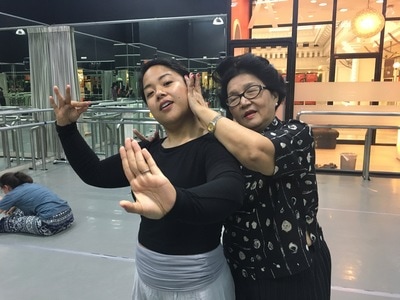
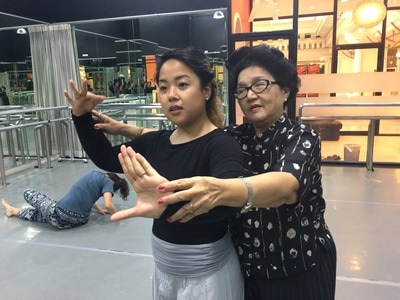
 RSS Feed
RSS Feed